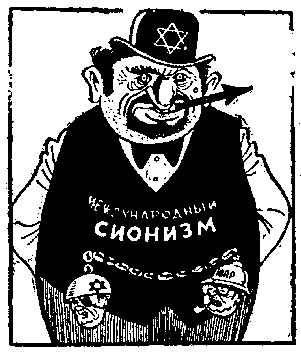Jews in the Soviet
Union from 1941
up to the end of the
Soviet era
(Part 5 of 8)
The Anti-Zionist Campaign
In opposition to "Imperialist" British policy, the Soviet Union initially supports the establishment of a Jewish state in 1947. But after Israel allies itself with the West, the Soviet Union, in its search for a position of power in the Middle East, changes sides. At home, traditional suspicions against Jews as a national group also shape attitudes towards Israel and Zionism.


At your left,
Cartoon from Gudok in which "International Zionism" is portrayed as
a person with traditional anti-Semitic features. Gudok,
August 4, 1973
At your right, the portrayal
of Jews as spiders, snakes, octopuses, etc., had always belonged to the anti-Semitic
arsenal. This example is from Sovjetskaia Moldavia, August 27, 1971.


At your left,
"The Tentacles of the Octopus" appeared in Krokodil in 1972.
At your right, "The New Prayer," a cartoon from Vechernaya Moskva
against Jewish activists, uses the well-known anti-Semitic image of the Jew
who for love of money will betray his country.1973
The already tense relationship deteriorates significantly after the Six Day War of June 1967. The decisive victory of Israel over its Arab neighbors, the political allies of the Soviet Union, is felt as a major debacle. In August 1967, a propaganda campaign is unleashed in the Soviet media denouncing Zionism and Israel. No distinction at all is made between Zionists and Jews.


At your left,
many cartoons equated Zionism or Israel with National Socialism, like this one:
"The Banner of the Zionist Gang" from Pravda Vostoka, December 1971.
At your right,
many classic anti-Semitic elements appear in this cartoon from "Agitator":
The fat Jew as a rich exploiter, the Star of David as the yoke of the masses,
the dollar sign as the sun; the writing in "Hebrew" style. Agitator
no. 12, June 1971.
In order to discredit the policy of Israel, anti-Semitic stereotypes dating back centuries appear in political cartoons, books and television programs. Anti-Semitic allegations of a "Jewish world conspiracy" are revived in phrases like "the global international Zionist network," active "behind the scenes" attempting to "establish world control" and supported by "smart dealers in politics and finance." The international broadcasts from Radio Moscow for months assail "Zionism" as the greatest danger to world peace.



At your left, Two of dozens
of anti-Zionist books: "Racism under a Blue Star," by E. Evseev,
1981
In the middle, "Present-day
Zionism," by V.A. Semenjuk, Minsk, 1986.
At your right, Postcard
for sale in Moscow in 1980.
Particularly vicious is the equation of Zionism with Nazism, a theme introduced by the Soviet Union in a session of the United Nations as early as October 1966. This propagandistic assault could have been effective only because the general public never obtained information about the fate of the Jews under the Nazi occupation.
Elsewhere in the communist bloc, anti-Semitism is used for political purposes as well. In the summer of 1968, the Polish authorities blame a conspiracy of "International Zionism" for the widespread political unrest. After an overt anti-Semitic campaign, practically all the remaining Polish Jews, most of them life-long communists, are dismissed from their jobs and forced to leave the country.